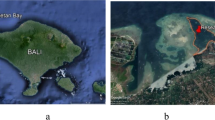Abstract
On the basis of field data measured during four cruises from January to November 2007, variations in the characteristics of dissolved inorganic nitrogen and phosphate were analyzed in Nansha marine fish cage culture area, Ningbo City, China. Dissolved inorganic nitrogen (DIN) was selected as the parameter to balance seaweed absorption and fish DIN production. The contents of DIN and phosphate varied with different seasons, and eutrophication index (E) value ranged from 2.41 to 15.99, indicating serious eutrophication conditions; the annual average value of N/P of 32.95 indicates a nitrogen surplus in this system. The eutrophication condition in Nansha Bay was mainly caused by the fish cage culture activities. Based on their biological characteristics, Laminaria and Gracilaria were selected as the bioremediation species in winter and spring and summer and autumn, respectively. The optimal co-cultivation proportion of fish cage to Laminaria and Gracilaria in this bay was 1 cage, 450 m2 and one cage, 690 m2, respectively.


Similar content being viewed by others
References
Bolton J, Robertson-Andersson DV, Troell M, Halling C (2006) Integrated system incorporates seaweeds in South African abalone culture. Global Aquac Adv 9:54–55
Brooks KM, Mahnken CVW (2003) Interaction of Atlantic salmon in the Pacific Northwest environment. II. Organic wastes. Fish Res 62:255–293
Buschmann AH, Riquelme VA, Hernández-González MC, Varela D, Jiménez JE, Henríquez LA, Vergara PA, Guíñez R, Luis F (2006) A review of the impacts of salmonid farming on marine coastal ecosystems in the southeast Pacific. ICES J Mar Sci 63:1338–1345
Carroll ML, Cochrane S, Fieler R, Velvin R, White P (2003) Organic enrichment of sediments from salmon farming in Norway: Environmental factors, management practices and monitoring techniques. Aquaculture 226:165–180
Chopin T, Buschmann AH, Halling C, Troell M, Kautsky N, Neori A, Kraemer N, Zertuche-González JA, Yarish C, Neefus C (2001) Integrating seaweeds into marine aquaculture systems: a key toward sustainability. J Phycol 37:975–986
GB17378.4 (2007) The specification for marine monitoring, part 4: seawater analysis. Standards Press of China, Beijing, p 162
Halwart M, Soto D, Arthur JR (2007) Cage aquaculture – Regional reviews and global overview. FAO Fisheries Technical Paper No. 498, Rome, p 241
Holmer M, Marba N, Duarte CM, Terrados J, Fortes MD (2002) Impact of milkfish (Chanos chanos) aquaculture on carbon and nutrient fluxes in the Bolonao area, Philippines. Mar Pollut Bull 44:685–696
Karakassis I, Tsapakis M, Hatziyanni E, Papadopoulou KN, Plaiti W (2000) Impact of cage farming of fish on the seabed in three Mediterranean coastal areas. ICES J Mar Sci 57:1462–1471
La Rosa T, Mirto S, Favaloro E, Savona B, Sara G, Danovaro R, Mazzola A (2002) Impact on the water column biogeochemistry of a Mediterranean mussel and fish farm. Water Res 36:713–721
Neori A, Chopin T, Troell M, Buschmann AH, Kraemer GP, Halling C, Shpigel M, Yarish C (2004) Integrated aquaculture: rationale, evolution and state of the art emphasizing seaweed biofiltration in modern mariculture. Aquaculture 231:361–391
Neori A, Troell M, Chopin T, Yarish C, Critchley A, Buschmann AH (2007) The need for a balanced ecosystem approach to blue revolution aquaculture. Environment 49:36–43
Ning XR, Hu XG (2005) Research and estimation on the ecology and carrying capacity of Yueqing Bay and Sanmen Bay. Ocean, Beijing pp 275
Ridler N, Robinson B, Chopin T, Robinson S, Page F (2006) Development of integrated multi-trophic aquaculture in the Bay of Fundy, Canada: a socio-economic case study. World Aquacult 37:43–48
Ridler N, Wowchuk M, Robinson B, Barrington K, Chopin T, Robinson S, Page F, Reid G, Haya K (2007) Integrated multi-trophic aquaculture (IMTA): a potential strategic choice for farmers. Aquacult Econ Manage 11:99–110
Sara G, Scilipoti D, Mazzola A, Modica A (2004) Effects of fish farming waste to sedimentary and particulate organic matter in a southern Mediterranean area (Gulf of Castellammare, Sicily): a multiple stable isotope study (δ13C and δ15N). Aquaculture 234:199–213
Stirling HP, Okumus I (1995) Growth and production of mussels (Mytilus edulis L.) suspended at salmon cages and shellfish farms in two Scottish lochs. Aquaculture 154:193–210
Troell M, Halling C, Neori A, Chopin T, Buschmann AH, Kautsky N, Yarish C (2003) Integrated mariculture: asking the right questions. Aquaculture 226:69–90
Troell M, Halling C, Nilsson A, Buschmann AH, Kautsky N, Kautsky L (1997) Integrated marine cultivation of Gracilaria chilensis (Gracilariales, Rhodophyta) and salmon cages for reduced environmental impact and increased economic output. Aquaculture 156:45–61
Troell M, Rönnbäck P, Halling C, Kautsky N, Buschmann A (1999) Ecological engineering in aquaculture: use of seaweeds for removing nutrients from intensive mariculture. J Appl Phycol 11:89–97
Wang XL, Cui ZG, Guo Q, Han XR, Wang JT (2009) Distribution of nutrients and eutrophication assessment in the Bohai Sea of China. Chin J Oceanol Limnol 27(1):177–183
Wu RSS, MacKay DW, Lau TC, Yam V (1994) Impact of marine fish farming on water quality and bottom sediment: a case study in the sub-tropical environment. Mar Environ Res 38:115–145
Zou JZ, Dong LP, Qin BP (1983) Preliminary studies on eutrophication and red tide problems in the Bohai Bay. Mar Environ Res 2(2):41–45
Acknowledgments
This work was supported by the National Basic Research Program of China (grant no. 2006CB400608) and the National High Technology Research and Development Program of China (grant no. 2006AA100304). The authors were grateful to Prof. Shi Huixiong and Mr. Jiao Haifeng of Ningbo Academy of Ocean and Fishery for their cooperation along this work and also to the very constructive comments by several reviewers.
Author information
Authors and Affiliations
Corresponding author
Rights and permissions
About this article
Cite this article
Jiang, Z.J., Fang, J.G., Mao, Y.Z. et al. Eutrophication assessment and bioremediation strategy in a marine fish cage culture area in Nansha Bay, China. J Appl Phycol 22, 421–426 (2010). https://doi.org/10.1007/s10811-009-9474-1
Received:
Revised:
Accepted:
Published:
Issue Date:
DOI: https://doi.org/10.1007/s10811-009-9474-1




